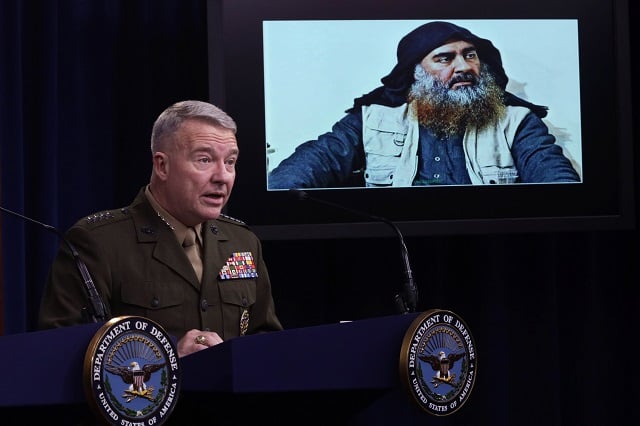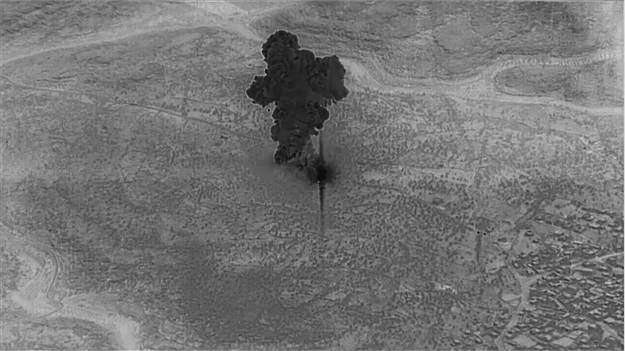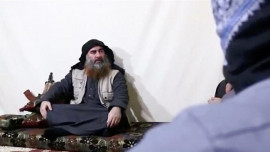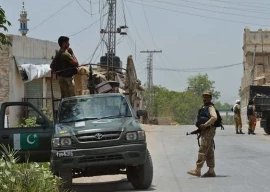
Among the images released by the Defense Department was grainy black-and-white footage of US troops approaching on foot the high-walled compound in northwestern Syria where Baghdadi was holed up.
"...at the compound, fighters from two locations in the vicinity of the compound began firing on U.S. aircraft participating in the assault."
- Gen Frank McKenzie CDR USCENTCOM pic.twitter.com/SkrtHNDs7w
— U.S. Central Command (@CENTCOM) October 30, 2019
The Pentagon also released a video of airstrikes on a group of unknown fighters on the ground who opened fire on the helicopters that ferried US forces in for the assault on Baghdadi's compound in Syria's Idlib province.
 US Marine Corps Gen Kenneth McKenzie, commander of US Central Command, speaks as a picture of the operation targeting Abu Bakr al-Baghdadi is seen during a press briefing. PHOTO: AFP
US Marine Corps Gen Kenneth McKenzie, commander of US Central Command, speaks as a picture of the operation targeting Abu Bakr al-Baghdadi is seen during a press briefing. PHOTO: AFPBefore and after pictures of the isolated compound were also released.
IS silent on Baghdadi death as it searches for successor
The compound was razed by US munitions after the raid, leaving it looking like "a parking lot with large potholes," said Marine Corps General Kenneth McKenzie, commander of US Central Command.
McKenzie, speaking to reporters at the Pentagon, also provided several new details about Sunday's raid.
He said that two children were killed - and not three as President Donald Trump previously said - when Baghdadi blew himself up with a suicide vest in a tunnel as he tried to escape US troops.
 This still image from video released by the US Department of Defense on October 30, 2019, shows smoke rising from the compound of ISIS leader Abu Bakr al-Baghdadi in Syria after it was destroyed in the US raid. PHOTO: AFP
This still image from video released by the US Department of Defense on October 30, 2019, shows smoke rising from the compound of ISIS leader Abu Bakr al-Baghdadi in Syria after it was destroyed in the US raid. PHOTO: AFPHe said the children appeared to be under 12 years old.
McKenzie was asked about Trump's claim that Baghdadi had fled into the tunnel "crying and whimpering."
"About Baghdadi's last moments, I could tell you this," he said. "He crawled into a hole with two small children and blew himself up while his people stayed on the ground."
Baghdadi "may have fired from his hole in his last moments," he added.
McKenzie said that in addition to Baghdadi and the two children, four women and one man were killed at the compound.
Al Baghdadi and the US media commentary
He said the women had acted in a "threatening manner" and were wearing suicide vests.
An unknown number of nearby fighters were also killed when they opened fire on US helicopters, McKenzie said.
Video released by the Pentagon showed airstrikes on a group that appeared to consist of up to a dozen or so people on the ground.
McKenzie declined to provide any further details about the two men captured in the raid but said that a "substantial" amount of electronics and documents had been recovered from the compound.
 This picture shows a side-by-side comparison of the compound of ISIS leader Abu Bakr al-Baghdadi in Syria before (L) and after the raid. PHOTO: AFP
This picture shows a side-by-side comparison of the compound of ISIS leader Abu Bakr al-Baghdadi in Syria before (L) and after the raid. PHOTO: AFPHe said Baghdadi had been identified through comparison with his DNA, which had been on file since his 2004 detention in an Iraqi prison.
He said Baghdadi's remains had been flown back to the staging base for the raid for identification.
Baghdadi was then buried at sea within 24 hours of his death "in accordance with the laws of armed conflict," McKenzie said.
He also provided details about the dog that pursued Baghdadi into the tunnel.
He said it was a four-year veteran of 50 combat missions and had been injured by exposed live cables in the tunnel, but has returned to duty.
McKenzie said that despite Baghdadi's death, IS remains "dangerous."
"We're under no illusions that it will go away just because we killed Baghdadi," he said. "It will remain."










































COMMENTS
Comments are moderated and generally will be posted if they are on-topic and not abusive.
For more information, please see our Comments FAQ